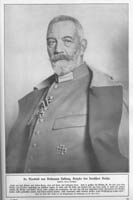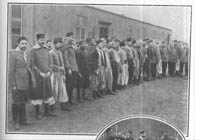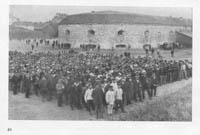Table of Contents
Media Index
CHAPTER 7
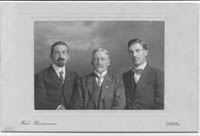
Portrait of three World's Alliance leaders: Theodore Giesendorf, left, World's Committee Secretary and director of the Commission Suisse Romande; Rudolf Horner, center, General Secretary of the Lisbon Association, he was recalled to Geneva to supervise the World's Alliance WPA program; and Davis A. Davis, right, Senior American Secretary in France during World War I.
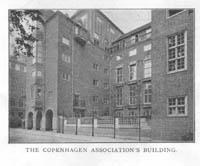
This is another view of the exterior of the Copenhagen YMCA building, which served as the national headquarters for the Danish Association.

Kurt W. von Pfuel was the Chairman of the Central Committee of the German National Red Cross during the First World War.
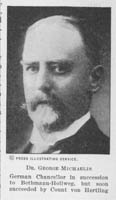
Georg Michaelis (1857-1936) was President of the German Christian Student Movement and served as the imperial Chancellor of Germany from July to November 1917.
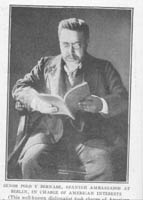
Portrait of Luis Polo de Bernabe, Spanish ambassador to Germany during the First World War; he safeguarded American interests in the German empire, including POW's, after the United States entered the war.

Prince Max of Baden (1867-1929) strongly supported the American YMCA's efforts to establish the WPA program in Germany and served as the last imperial Chancellor of Germany.
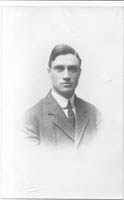
Portrait of Edgar MacNaughten (1882-1933), the American YMCA Senior WPA Secretary in Austria-Hungary from 1916 to 1917; MacNaughton became the Senior American Navy Secretary Overseas in 1918.
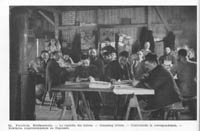
German authorities censor the mail of Allied prisoners of war at the prison camp at Parchim. While some prisoners provided clerical support, German translators (most likely the civilians) review the letters for contraband information.
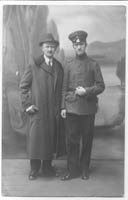
J. Gustav White (1881-1979), left in civilian clothing, poses for a photograph with a German military translator; White was an American YMCA secretary who worked for the WPA in Germany from 1916 to 1917. Although most Association secretaries spoke the native languages of the POW's, German translators accompanied the Y workers to fulfill security regulations in many camps. White later transferred to Geneva where he became the Education Secretary for the World's Alliance of YMCA's.
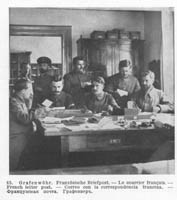
French prisoners route letters to their comrades in the prison post office at Grafenwoehr under the supervision of a German non-commissioned officer. These letters have been approved by the German censors for distribution. Censors also worked as interpreters between prisoners, German officials, WPA secretaries, and neutral visitors.
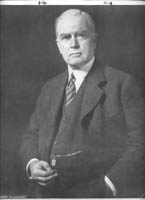
Portrait of an older John R. Mott (1865-1955), General Secretary of the International Committee of the North American YMCA beginning in 1915 and General Secretary of the World's Committee of the World's Alliance in 1926.
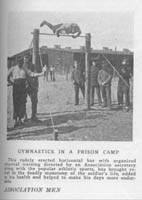
British and French prisoners of war watch a fellow prisoner display his gymnastics prowess on the horizontal bar. A YMCA secretary arranged for the installation of the bar and organized a physical training program for the POWs to help them passs their free time and improve their physical fitness.
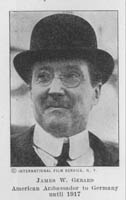
Ambassador James W. Gerard (1867-1951) became the United States ambassador to Berlin in 1913 and represented Allied interests until the United States broke diplomatic relations with Germany in February 1917.
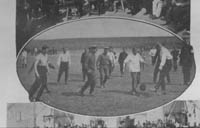
Russian prisoners compete in a game of soccer in an unidentified German prison camp in this YMCA photograph. The introduction of sports in prison camps provided the POW's with healthy competition and a relief from the monotony of life behind barbed-wire.

Allied prisoners muster in front of their barracks in the prison compound at Dyrotz for a roll call. English prisoners stand to the right, Russians in the middle, and French POW's to the right. On the lower right hand side of the photograph are the wagons and tools used to support the prison camp on a daily basis.
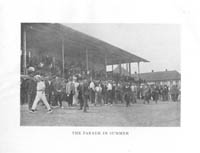
A considerable number of British internees took advantage of the fine weather to walk along the race track at Ruhleben during the summer. Others were content to socialize in the grand stands behind the strollers.

Newly captured Russian prisoners march from the railway station to the prison camp at Schneidemuehl under a Landsturm guard.
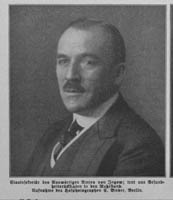
Gottlieb von Jagow (1863-1935) was the German Foreign Secretary at the beginning of World War I and held this office until November 1916.
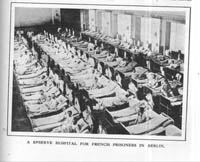
French prisoners of war recover from their wounds in one of the special hospitals established in Berlin by the German authorities. When the patients were finally discharged from the ward, they were transferred to a Stammlager and sent to a labor detachment or exchanged for German prisoners if their wounds were severe.

Recently captured French prisoners march through the town square in France enroute to the railway station under German guard. A group of German officers and French women watch the procession.
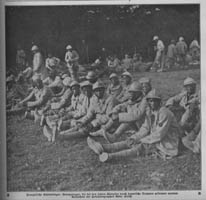
Recently captured by Bavarian troops, these Senegalese soldiers will join their French comrades behind them in captivity in Germany. The German caption calls these colonial troops "Franzoesische Kulturtraeger" ("Conveyors of French Culture") to highlight the Allies' dependence on colonial forces for their security.
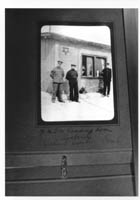
Two British soldiers and a sailor stand outside of the YMCA Reading Room at Doeberitz. The photograph caption indicates that these men were members of the YMCA camp committee. The room is busy as several POW's look out the window at the photographer.
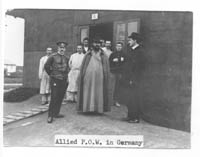
An unidentified YMCA secretary, on the right, stands outside a lazaret in a German prison camp with a Russian doctor and an unknown civilian (in the center). A French orderly and several patients pose by the door of the lazarette.

A panoramic view of the prison camp at Rennbahn (Muenster II) showing how the facility was divided into four quarters by two perpendicular streets. Barracks formed the perimeter of the compound. Note the tennis courts in the center of the compound, on the street running to the left.
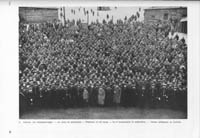
With German troops in the foreground and sentries ringing the prisoners, several hundred Russian POW's assemble for a photograph in the prison compound at Guben.
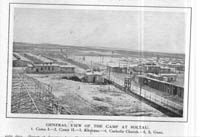
This photograph depicts a panoramic view of the prison camp at Soltau and identifies the two compounds, the kitchens, and the Roman Catholic church. Most of the barracks in the camp are the typical one-story wooden buildings found in many German prison camps.
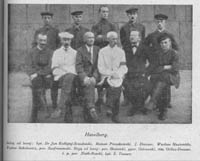
In this photograph, a group of Polish civilians and Polish legionnaires pose in the prison compound at Havelberg. Their refusal to swear an oath of allegiance to the new Polish regency in Warsaw forced the Germans to intern them for the remainder of the war.
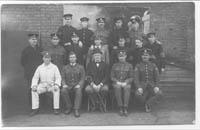
Claus Olandt (the civilian seated in the center of the photo), an American YMCA WPA secretary working in Germany, poses outdoors with fifteen British POW's at Muenster after a church service.
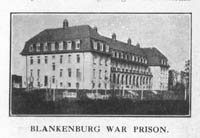
Exterior photograph of the prison facility at Blankenburg, a prison camp for Allied officers in Brandenburg. The building was surrounded by barbed-wire fences to deter escape attempts.
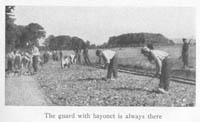
French prisoners in wooden shoes are hard at work repairing a road on a labor detachment under the careful supervision of German guards, armed with bayonets.
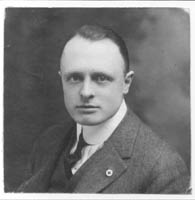
Portrait of Ernst Offo Jacob (1886-1966); he first served as a YMCA secretary in Constantinople from 1910 to 1916 before he transferred to Germany to serve as an American YMCA WPA Secretary in Saxony.

A group of Russian prisoners of war turn over the soil in a field in Spring 1915 in preparation for the planting of potatoes. The Germans began to recognize that idle prisoners in camps were a drain on their war economy and these labor detachments, especially in agricultural production, would become very common across Germany by the end of the war.

J. Spencer Kennard was an American YMCA WPA Secretary who conducted relief operations for Allied POW's in Germany during World War I.
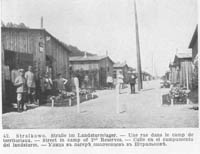
German soldiers and prisoners stand on a street in the prison compound in Stralkowo. Wooden barracks line the street and tall utility poles stand in the middle of the thoroughfare. Note the flower gardens which are carefully tended in front of each barrack. These gardens provided prisoners with some pastime to decorate the outside of their accommodations.
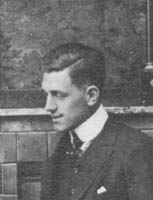
Joseph E. Wehner (d. 1918) was an American YMCA WPA Secretary in Germany from 1916 to 1917; he was killed on the Western Front in 1918.
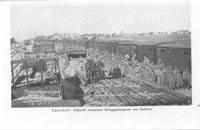
As Austro-German forces mounted a counter-offensive in Galacia in 1915, droves of Russian prisoners arrived at German prisons. Hundreds of recently captured Russian POW's disembark from their railway cars at the train station at Lamsdorf while German guards watch attentively behind the pile of logs.
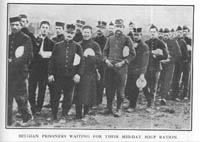
Belgian prisoners of war line up for their lunch rations with their soup bowls in hand in an unidentified German prison camp.
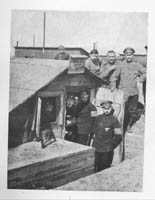
Russian prisoners stand at the entrance to their earthen barrack at Hammerstein in 1914. These barracks offered few windows, which limited ventilation, but prevented the escape of heat, a major consideration during the long, cold winters of eastern Germany. This particular building was a temporary facility which held prisoners while permanent barracks were constructed.
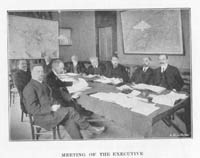
The members of the Executive Committee of the World's Committee met on a monthly basis in the World's Alliance headquarters in Geneva. This photograph was taken in 1913 and many of these men would soon return home to support the young men called to their nations' colors.
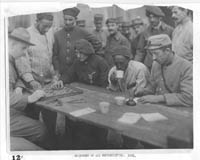
An American prisoner of war, left, and a French POW play a game of checkers while another French soldier, sitting on the bench to the right, writes a letter. Two French colonial troopers intently watch the game while another colonial enjoys a drink. German prison camps became a "melting pot" for men from around the world.
